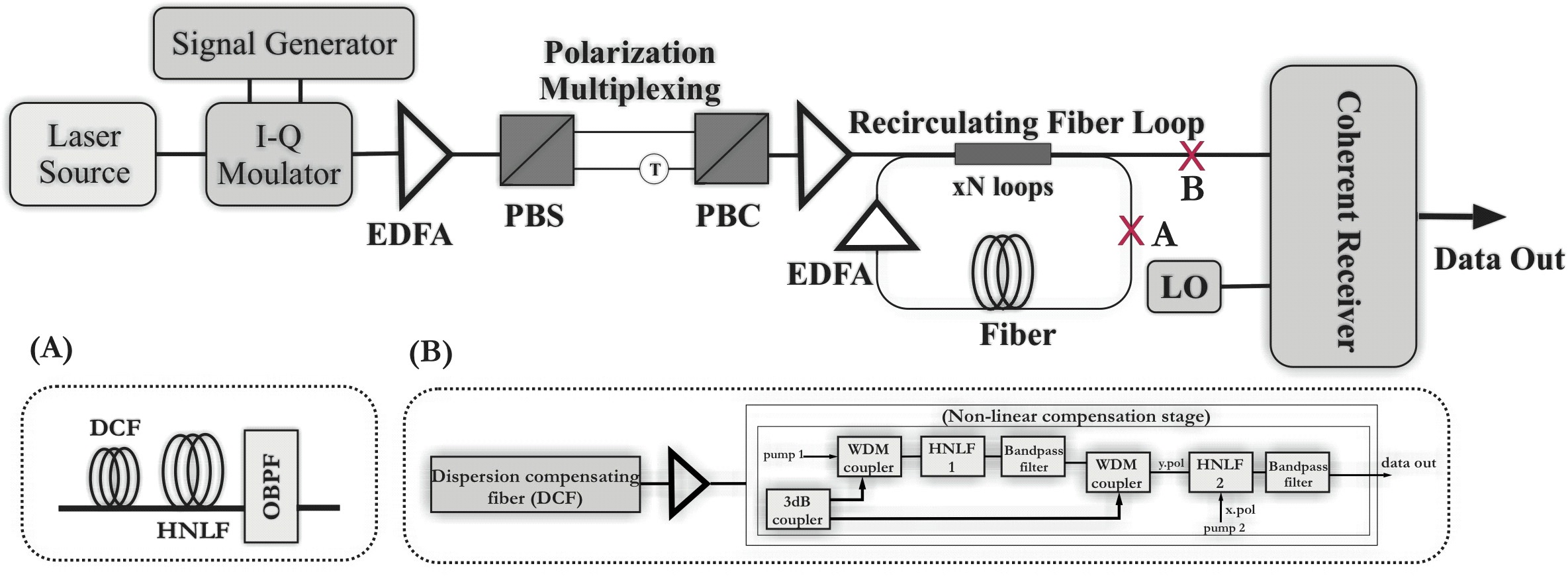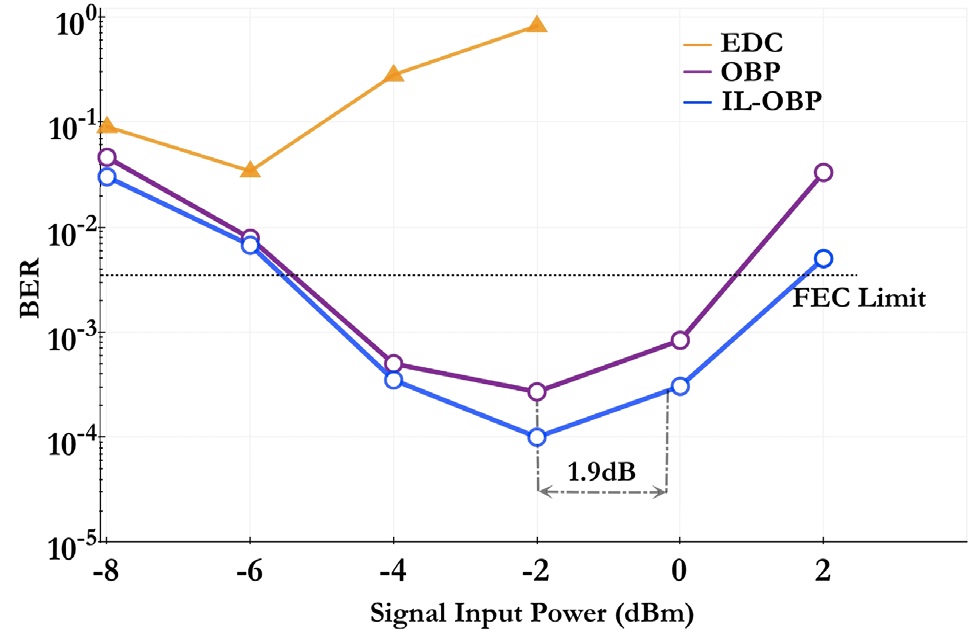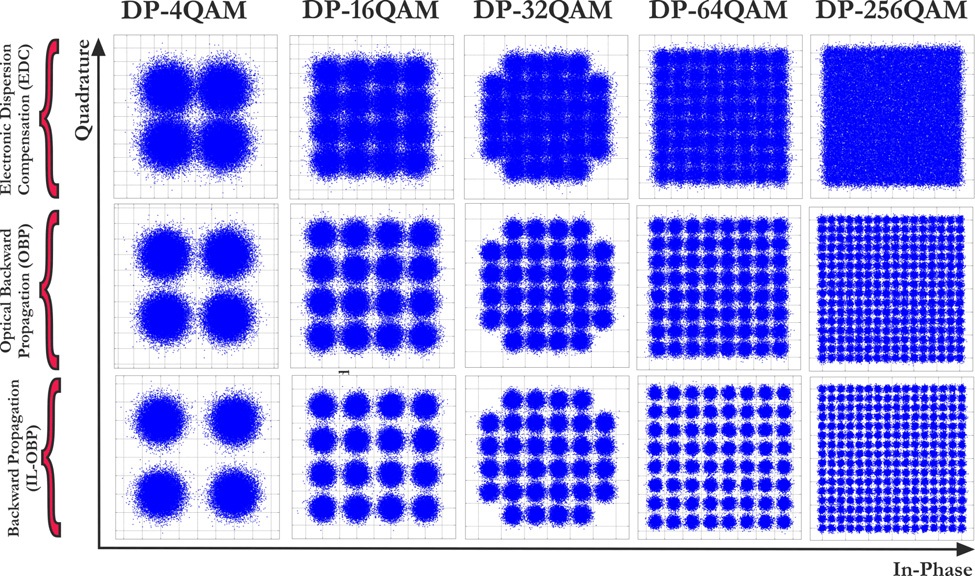



Digital compensation of linear and non-linear signal distortions with backward propagation algorithm (DBP) is a topic of high interest in recent months, to improve the non-linear tolerance of optical communication systems. With higher baud-rates and advanced modulation formats, channel capacity [1,2] is limited by the signal degradation due to fiber non-linearity, as it increases with signal input power. The DBP algorithm allows joint compensation of chromatic dispersion (CD) and non-linearities (NL) [3-6] along with the coherent receiver. It can be implemented by inversely solving the non-linear Schrodinger equation (NLSE) using split-step Fourier methods (SSFM). It is demonstrated that DBP in a single channel transmission can be improved by using a modified split-step Fourier method (M-DBP) [7,8]. M-DBP is based on the optimization of non-linear calculation point (NLCP). In order to reduce the complexity of the algorithm, the correlated DBP (CBP) algorithm is introduced in [9,10]. The performance of DBP algorithm is evaluated for diverse baud-rates i.e., 14Gbaud, 28Gbaud and 56Gbaud with QPSK modulation formats [11-14]. Especially with the introduction of logarithmic step-size based DBP algorithm (L-DBP) [12-14], which shows efficient system performance as compared to M-DBP, the nonlinear threshold point (NLT) of higher baud-rates transmissions are significantly improved. Due to exponentially growing global bandwidth demand, polarization-division multiplexed 16 state quadrature amplitude modulation (PDM 16-QAM) with high spectral efficiency (SE) is becoming a promising candidate to achieve per channel bit-rates beyond 100 Gbit/s and has been the subject of extensive research [15-19]. The multi-channel transmission performance over 670 km SMF and 656 km LA-PSCF fiber is reported in [16,17]. Whereas; the evaluation of DBP algorithm in 224 Gbit/s PM-16QAM system over 250 km of SMF with un-compensated link is reported in [19], with 3.5dB of Q-improvement in the performance.
However, this high SE is obtained at the expense of complicated transmitter and receiver structures, higher OSNR requirements and dense constellation diagrams, which collectively make them less robust against fiber transmission impairments i.e., chromatic dispersion (CD) and non-linearities (NL). But also the complexity of the DBP algorithm is extremely high due to ultra-wide band-width requirements that it becomes an intrinsic impediment in the real-time implementation of the DBP algorithm. To overcome the computational complexities of digital backward propagation, an alternative approach of optical backward propagation (OBP) is proposed [20]. The OBP module consists of dispersion compensating fiber (DCF) and non-linearity compensator (NLC). In the NLC part of the OBP, an effective negative Kerr non-linear coefficient using two highly non-linear fibers is realized. As a result NLC imparts a phase shift that is equal in magnitude to the non-linear phase shift due to fiber propagation, but opposite in sign, the same as the non-linear operator (N) in digital backward propagation.
It is a well-known fact that in the all-optical signal processing techniques intensity fluctuation is a serious problem [21]. To date, numerous techniques for optical intensity stabilization including optical limiters, optical reshaping techniques and optical regenerators have been evaluated [21-23]. Among them, the techniques that are based on self-phase modulation (SPM) methods are more stable, having less complexity and supporting higher bit rates, i.e. 100 Gbit/s and beyond [23,24]. The SPM achieve limiting function by extracting the center frequency part of optical pulses after the SPM. After the input peak intensity reaches a certain threshold, the energy around the center frequency is spread out to both its frequency sides. As a result, the intensity around the center frequency can ideally keep balance between input and spread out energies. However, the behavior of the SPM is not ideal and the amount of spread out energy becomes larger or smaller than the input energy after a certain threshold point and intensity of optical pulses extracted starts varying [25]. To avoid this artifact, a stable SPM-based
all-optical intensity limiter is proposed [26] based on the pre-chirping procedure. The intensity of center wavelength components depends on how the input pulse is chirped. Moreover, by adding an appropriate amount of chirp, the center wavelength intensity stabilization through a single SPM limiter can be achieved.
In this paper, we have numerically implemented optical backward propagation (OBP) and evaluated it for dual-polarization (DP) m-ary (m=4,16,32,64,256) quadrature amplitude modulation (QAM) in 112 Gbit/s coherent transmission over standard single mode fiber (SMF). OBP module jointly compensates CD and NL and gives enhanced system performance as compared to the electronic dispersion compensation (EDC), or in other words, linear equalization (LE) realized by the finite impulse response (FIR) filters. We have also investigated intensity limited optical backward propagation (IL-OBP) by using a self-phase modulation (SPM) based optical limiter with an appropriate pre-chirping to compensate for the intensity fluctuations in the transmission link. The IL-OBP gives improved system performance as compared to conventional OBP.
Figure 1 illustrates the numerical model of a single channel dual-polarization quadrature amplitude modulation (DP-QAM) based transmission system operated at a bit rate of 112 Gbit/s and at a wavelength of 1550 nm. The data stream consists of 216 - 1 pseudo-random binary sequence (PRBS). To simplify our numerical analysis and to focus on the deterministic transmission impairments, i.e. CD and NL, we neglect the effect of polarization mode dispersion (PMD) and laser line width. We configured 5 transmission systems, i.e. DP-4QAM, DP-16QAM, DP-32QAM, DP-64QAM and DP-256QAM, operating at the baud rates of 28Gbaud, 14Gbaud, 11.2Gbaud, 9.33Gbaud and 7Gbaud respectively. The signals are transmitted over 1200 km standard SMF (15 spans × 80 km) with physical parameters of dispersion D=16 ps/nm-km, non-linear coefficient γ=1.3 (km-1.W-1) and attenuation constant
After processing the signals by the optical backward propagation module, a homodyne coherent, polarization and phase diversity receiver is used consisting of 2×4 90° optical hybrids followed by balanced detectors. The signal is sampled at two samples per symbol and passed on to the DSP module. An anti-aliasing 2nd- order low pass (LP) Gaussian filter is also used at the receiver. The sampled signal goes through the DSP module having the adaptive polarization de-multiplexing which is realized by finite impulse response butterfly equalizer using the constant-modulus algorithm. It is assisted by the phase error estimation module based on the Viterbi-and- Viterbi algorithm which is able to remove small residual constellation rotations. When the chromatic dispersion is digitally compensated [electronic dispersion compensation (EDC)], finite impulse response (FIR) filters are used (T/2-spaced taps) and is adapted using a least mean square (LMS) algorithm. The transmission performances are compared by Q-factor (dB) and bit-error-ratio (BER) analysis, whereas the Q-factor (dB) is directly calculated from BER by using BER =
and the FEC limit corresponds to BER=3.8×10-3.
Figure 1(a) depicts the basic block diagram of the SPM-based all-optical intensity limiter which is placed in the main transmission system at point (A) for IL-OBP and removed for conventional implementation of OBP. This module consists of an EDFA, DCF, HNLF and an optical band-pass filter (OBPF), cascaded together [26]. An amplified optical signal is passed through a DCF to add the up-chirp in the signal. Then the signal enters in HNLF having the physical parameters of length (L)=1.5 km, D=0.5 ps/nm-km, γ=11.5 (km-1.W-1),
ps/nm2-km and
Figure 2 depicts the comparative analysis of EDC, optical backward propagation (OBP) and intensity limited optical backward propagation (IL-OBP). The results of single channel 112 Gbit/s DP-64QAM transmission over 1200 km standard single mode fiber are as shown in Fig. 2. The system performance is quantified by means of bit-error-ratio (BER) as a function of single launch power. The results depict improved system performance in both the cases of optical backward propagation (OBP), as compared to EDC, which shows efficient joint compensation of CD and NL.
Firstly, the conventional OBP is numerically investigated for the above mentioned transmission system. The maximum system performance is achieved at a signal launch power of -2dBm. The non-linear threshold point (NLT) is improved by 4dBm as compared to EDC. Then as a next step, IL-OBP is numerically investigated which was realized by implementing an SPM based all-optical intensity limiter. This scheme has further improved the system performance by suppressing the intensity fluctuations in the transmission link. The system performance by using IL-OBP is improved by a factor of 1.9 dB of signal input power for same reference amount of BER for OBP at NLT point. The implementations of both the OBP techniques correspond to the implementation of compensating fiber transmission impairments in one step for the whole transmission link. Whereas, for DP-64QAM transmission system to get the efficient system performance by DBP, 40 step per fiber span were processed [18]. This means that OBP concept has a very low complexity and can be used as a real time
signal processing modules with coherent receivers. Fig. 3 qualitatively depicts, in-terms of constellation diagrams, the performance comparison of OBP and IL-OBP at the non-linear threshold point (NLT) and also the corresponding performance of EDC for the same transmission distance for 112 Gbit/s DP m-ary QAM (m=4,16,32,64,256). The results show improved system performance and enhanced transmission distance of IL-OBP as compared to conventional OBP. As mentioned earlier, in our numerical analysis we neglect the PMD effect, which is a stochastic process, and we are emphasizing on the compensation of deterministic fiber impairments, i.e. CD and NL. Otherwise due to PMD, polarization dependent loss can effect the performance of the system and it is necessary to have polarization tracking or in other words the polarization alignment between pumps and signal in all-optical signal processing methods.
To estimate the maximum system performance by implementing EDC, OBP and IL-OBP, we have evaluated the Q-factor (dB) as a function for diverse transmission distances for all the modulation formats, as shown in Fig. 4. It can be seen from the results that DP- 4QAM transmission has the maximum reach in terms of transmission distance in km. Furthermore, the results from OBP and IL-OBP also complement the fact that transmission reduces by a factor of ? 3 times for a 2 unit increase in capacity (log2m). The results in Fig. 4 show additional reduction of transmission distance by a factor of 0.5 as compared to the results reported in [18]. This is due to the fact of DCF induced discrepancies in OBP, while all the CD is compensated digitally in DBP. Therefore the launch power to the DCF is kept low in this numerical analysis so that the non-linear effects in the DCF can be negligibly small.
We have further summarized and compared the improvement in the transmission performance for each modulation for 112 Gbit/s DP m-ary QAM (m=4,16,32,64,256) transmission achieving a minimum BER of ?10-3. The results are as shown in Fig. 5, where the largest system improvements (when OBP and IL-OBP are compared with EDC) are depicted in higher-order modulation formats. This is
due to the fact of reduced dispersive effects in higher order modulation formats with lower baud rates as discussed in the numerical model section. To summarize, the DP- 256QAM transmission attains a transmission distance of 580 km with OBP for a minimum BER of ?10-3 as compared to 960 km with IL-OBP, which depict ?66% increment in maximum reach. The overall results depict that IL-OBP performs efficiently with higher order modulation formats, i.e. DP-64QAM, DP-256QAM, by suppressing intensity fluctuations or in other words limiting amplitude noise in the transmission link.
In this paper, we have discussed the transmission performance of optical backward propagation (OBP) for 112 Gbit/s DP m-ary QAM (m=4,16,32,64,256) system over SMF fiber. The results depict efficient compensation of CD and NL and shows better performance as compared to
EDC over the range of modulation formats listed above. We have further demonstrated that the additional improvement in system performance can be obtained with a self-phase modulation (SPM) based optical limiter with an appropriate pre-chirping to compensate for the intensity fluctuations in the transmission link. The results depict that in DP-256QAM transmission, we have observed a 66% increase in the transmission distance by implementing IL-OBP as compared to conventional OBP. From the results, it is evident that this scheme of fiber transmission impairment compensation with very low complexity can be used as a real time signal processing modules with coherent receivers as compared to DBP, where the computational effort and bandwidth required for higher order modulation formats would be prodigious.






![Q-factor [dB] as a function of various transmission distances for 112 Gbit/s DP m-ary QAM (m=4,16,32,64,256) transmission.](http://oak.go.kr/repository/journal/12178/E1OSAB_2013_v17n1_57_f004.jpg)
